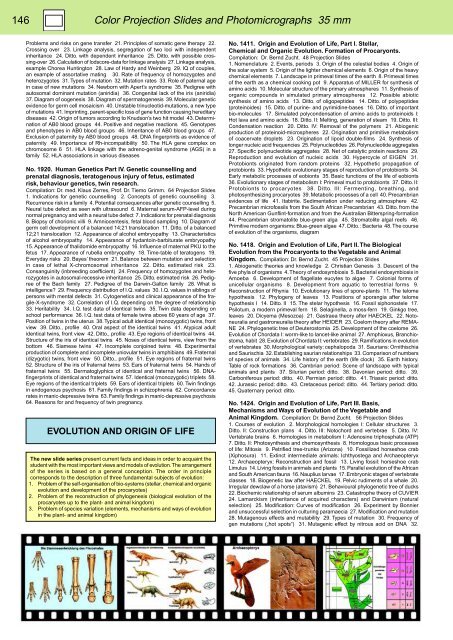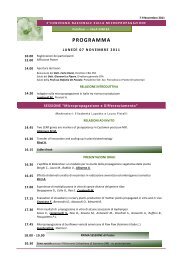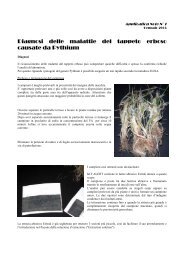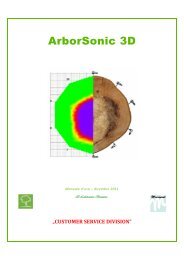BIOLOGY - microscopia.info
BIOLOGY - microscopia.info
BIOLOGY - microscopia.info
Create successful ePaper yourself
Turn your PDF publications into a flip-book with our unique Google optimized e-Paper software.
146<br />
Color Projection Slides and Photomicrographs 35 mm<br />
Problems and risks on gene transfer 21. Principles of somatic gene therapy 22.<br />
Crossing over 23. Linkage analysis, segregation of two loci with independent<br />
inheritance 24. Ditto. with dependent inheritance 25. Ditto. with possible crossing-over<br />
26. Calculation of lodscore-data for linkage analysis 27. Linkage analysis,<br />
example Chorea Huntington 28. Law of Hardy and Weinberg 29. IQ of couples,<br />
an example of assortative mating 30. Rate of frequency of homozygotes and<br />
heterozygotes 31. Types of mutation 32. Mutation rates 33. Role of paternal age<br />
in case of new mutations 34. Newborn with Apert’s syndrome 35. Pedigree with<br />
autosomal dominant mutation (aniridia) 36. Congenital lack of the iris (aniridia)<br />
37. Diagram of oogenesis 38. Diagram of spermatogenesis 39. Molecular genetic<br />
evidence for germ cell mosaicism 40. Unstable trinucleotid-mutations, a new type<br />
of mutations 41. Imprinting, parent-specific loss of gene function causing hereditary<br />
diseases 42. Origin of tumors according to Knudson’s two hit model 43. Determination<br />
of AB0 blood groups 44. Positive and negative reactions 45. Genotypes<br />
and phenotypes in AB0 blood groups 46. Inheritance of AB0 blood groups 47.<br />
Exclusion of paternity by AB0 blood groups 48. DNA fingerprints as evidence of<br />
paternity 49. Importance of Rh-incompatibility 50. The HLA gene complex on<br />
chromosome 6 51. HLA linkage with the adreno-genital syndrome (AGS) in a<br />
family 52. HLA associations in various diseases<br />
No. 1920. Human Genetics Part IV. Genetic counselling and<br />
prenatal diagnosis, teratogenous injury of fetus, estimated<br />
risk, behaviour genetics, twin research.<br />
Compilation: Dr. med. Klaus Zerres, Prof. Dr. Tiemo Grimm. 64 Projection Slides<br />
1. Indications for genetic counselling 2. Concepts of genetic counselling 3.<br />
Recurrence risk in a family 4. Potential consequences after genetic counselling 5.<br />
Neural tube defect as seen with ultrasound 6. Maternal serum-AFP-level during<br />
normal pregnancy and with a neural tube defect 7. Indications for prenatal diagnosis<br />
8. Biopsy of chorionic villi 9. Amniocentesis, fetal blood sampling 10. Diagram of<br />
germ cell development of a balanced 14;21 translocation 11. Ditto. of a balanced<br />
12;21 translocation 12. Appearance of alcohol embryopathy 13. Characteristics<br />
of alcohol embryopathy 14. Appearance of hydantoin-barbiturate embryopathy<br />
15. Appearance of thalidomide embryopathy 16. Influence of maternal PKU to the<br />
fetus 17. Appearance of rubella embryopathy 18. Time-table of teratogens 19.<br />
Everyday risks 20. Bayes’ theorem 21. Balance between mutation and selection<br />
in case of lethal X-chromosomal inheritance 22. Ditto. estimated risk 23.<br />
Consanguinity (inbreeding coefficient) 24. Frequency of homozygotes and heterozygotes<br />
in autosomal-recessive inheritance 25. Ditto. estimated risk 26. Pedigree<br />
of the Bach family 27. Pedigree of the Darwin-Galton family 28. What is<br />
intelligence? 29. Frequency distribution of I.Q. values 30. I.Q. values in siblings of<br />
persons with mental defects 31. Cytogenetics and clinical appearance of the fragile-X-syndrome<br />
32. Correlation of I.Q. depending on the degree of relationship<br />
33. Heritability 34. I.Q. test data of identical twins 35. Twin data depending on<br />
school performance 36. I.Q. test data of female twins above 60 years of age 37.<br />
Position of twins in the uterus 38. Typical adult identical (monozygotic) twins, front<br />
view 39. Ditto., profile 40. Oral aspect of the identical twins 41. Atypical adult<br />
identical twins, front view 42. Ditto., profile 43. Eye regions of identical twins 44.<br />
Structure of the iris of identical twins 45. Noses of identical twins, view from the<br />
bottom 46. Siamese twins 47. Incomplete conjoined twins 48. Experimental<br />
production of complete and incomplete uniovular twins in amphibians 49. Fraternal<br />
(dizygotic) twins, front view 50. Ditto., profile 51. Eye regions of fraternal twins<br />
52. Structure of the iris of fraternal twins 53. Ears of fraternal twins 54. Hands of<br />
fraternal twins 55. Dermatoglyphics of identical and fraternal twins 56. DNAfingerprints<br />
of identical and fraternal twins 57. Identical (monozygotic) triplets 58.<br />
Eye regions of the identical triplets 59. Ears of identical triplets 60. Twin findings<br />
in endogenous psychosis 61. Family findings in schizophrenia 62. Concordance<br />
rates in manic-depressive twins 63. Family findings in manic-depressive psychosis<br />
64. Reasons for and frequency of twin pregnancy.<br />
EVOLUTION AND ORIGIN OF LIFE<br />
The new slide series present current facts and ideas in order to acquaint the<br />
student with the most important views and models of evolution. The arrangement<br />
of the series is based on a general conception. The order in principle<br />
corresponds to the description of three fundamental subjects of evolution:<br />
1. Problem of the self-organisation of bio-systems (stellar, chemical and organic<br />
evolution and development of the procaryotes)<br />
2. Problem of the reconstruction of phylogenesis (biological evolution of the<br />
procaryotes up to the plant- and animal kingdom)<br />
3. Problem of species variation (elements, mechanisms and ways of evolution<br />
in the plant- and animal kingdom)<br />
No. 1411. Origin and Evolution of Life, Part I. Stellar,<br />
Chemical and Organic Evolution. Formation of Procaryonts.<br />
Compilation: Dr. Bernd Zucht. 48 Projection Slides<br />
1. Nomenclature 2. Events, periods 3. Origin of the celestial bodies 4. Origin of<br />
the solar system 5. Origin of the lighter chemical elements 6. Origin of the heavy<br />
chemical elements 7. Landscape in primeval times of the earth 8. Primeval times<br />
of the earth as a chemical cooking pot 9. Apparatus of MILLER for synthesis of<br />
amino acids 10. Molecular structure of the primary atmospheres 11. Synthesis of<br />
organic compounds in simulated primary atmospheres 12. Possible abiotic<br />
synthesis of amino acids 13. Ditto. of oligopeptides 14. Ditto. of polypeptides<br />
(proteinoides) 15. Ditto. of purine- and pyrimidine-bases 16. Ditto. of important<br />
bio-molecules 17. Simulated polycondensation of amino acids to proteinoids I:<br />
Hot lava and amino acids 18. Ditto. II: Melting, generation of steam 19. Ditto. III:<br />
Condensation reaction 20. Ditto. IV: Removal of the polymers 21. Abiogenic<br />
production of proteinoid-microspheres 22. Origination and primitive metabolism<br />
of coacervate droplets 23. Origination of lipoid double-films 24. Synthesis of<br />
longer nucleic acid frequencies 25. Polynucleotides 26. Polynucleotide aggregates<br />
27. Specific polynucleotide aggregates 28. Net of catalytic protein reactions 29.<br />
Reproduction and evolution of nucleic acids 30. Hypercycle of EIGEN 31.<br />
Protobionts originated from random proteins 32. Hypothetic propagation of<br />
protobionts 33. Hypothetic evolutionary stages of reproduction of protobionts 34.<br />
Early metabolic processes of eobionts 35. Basic functions of the life of eobionts<br />
36. Evolutionary stages of metabolism I: Primeval mud to protobionts 37. Ditto. II:<br />
Protobionts to procaryotes 38. Ditto. III: Fermenting, breathing, and<br />
photosynthesizing procaryotes 39. Metabolic processes of a cell 40. Precambrian<br />
evidences of life 41. Itabirite. Sedimentation under reducing atmosphere 42.<br />
Precambrian microfossils from the South African Precambrian 43. Ditto. from the<br />
North American Gunflint-formation and from the Australian Bitterspring-formation<br />
44. Precambrian stromatolite blue-green alga 45. Stromatolite algal reefs 46.<br />
Primitive modern organisms: Blue-green algae 47. Ditto. : Bacteria 48. The course<br />
of evolution of the organisms, diagram<br />
No. 1418. Origin and Evolution of Life, Part II. The Biological<br />
Evolution from the Procaryonts to the Vegetable and Animal<br />
Kingdom. Compilation: Dr. Bernd Zucht. 45 Projection Slides<br />
1. Abiogenetic theories and knowledge 2. Christian Genesis 3. Descent of the<br />
five phyla of organisms 4. Theory of endosymbiosis 5. Bacterial endosymbiosis in<br />
Amoeba 6. Development of flagellate eucytes to algae 7. Colonial forms of<br />
unicellular organisms 8. Development from aquatic to terrestrial forms 9.<br />
Reconstruction of Rhynia 10. Evolutionary lines of spore-plants 11. The telome<br />
hypothesis 12. Phylogeny of leaves 13. Positions of sporangia after telome<br />
hypothesis I 14. Ditto. II 15. The stelar hypothesis 16. Fossil siphonostele 17.<br />
Psilotum, a modern primeval fern 18. Selaginella, a moss-fern 19. Ginkgo tree,<br />
leaves 20. Dicyema (Mesozoa) 21. Gastraea theory after HAECKEL 22. Notoneuralia<br />
and gastroneuralia theory after HEIDER 23. Coelom theory after REMA-<br />
NE 24. Phylogenetic tree of Deuterostomia 25. Development of the coelome 26.<br />
Evolution of Chordata I: worm-like to lancet-like animal 27. Amphioxus, Branchiostoma,<br />
habit 28. Evolution of Chordata II: vertebrates 29. Ramifications in evolution<br />
of vertebrates 30. Morphological variety: cephalopoda 31. Saurians: Ornithischia<br />
and Saurischia 32. Establishing saurian relationships 33. Comparison of numbers<br />
of species of animals 34. Life history of the earth (life clock) 35. Earth history.<br />
Table of rock formations 36. Cambrian period: Scene of landscape with typical<br />
animals and plants 37. Silurian period: ditto. 38. Devonian period: ditto. 39.<br />
Carboniferous period: ditto. 40. Permian period: ditto. 41. Triassic period: ditto.<br />
42. Jurassic period: ditto. 43. Cretaceous period: ditto. 44. Tertiary period: ditto.<br />
45. Quaternary period: ditto.<br />
No. 1424. Origin and Evolution of Life, Part III. Basis,<br />
Mechanisms and Ways of Evolution of the Vegetable and<br />
Animal Kingdom. Compilation: Dr. Bernd Zucht. 56 Projection Slides<br />
1. Courses of evolution 2. Morphological homologies I: Cellular structures 3.<br />
Ditto. II: Construction plans 4. Ditto. III: Notochord and vertebrae 5. Ditto. IV:<br />
Vertebrate brains 6. Homologies in metabolism I: Adenosine triphosphate (ATP)<br />
7. Ditto. II: Photosynthesis and chemosynthesis 8. Homologous basic processes<br />
of life: Mitosis 9. Petrified tree-trunks (Arizona) 10. Fossilized horseshoe crab<br />
(Xiphosura) 11. Extinct intermediate animals: Ichthyostega and Archaeopteryx<br />
12. Archaeopteryx: Reconstruction and fossil 13. Living fossil: horseshoe crab<br />
Limulus 14. Living fossils in animals and plants 15. Parallel evolution of the African<br />
and South American fauna 16. Nauplius larvae 17. Embryonic stages of vertebrate<br />
classes 18. Biogenetic law after HAECKEL 19. Pelvic rudiments of a whale 20.<br />
Irregular dewclaw of a horse (atavism) 21. Behavioural phylogenetic tree of ducks<br />
22. Biochemic relationship of serum albumins 23. Catastrophe theory of CUVIER<br />
24. Lamarckism (inheritance of acquired characters) and Darwinism (natural<br />
selection) 25. Modification: Curves of modification 26. Experiment by Bonnier<br />
and unsuccessful selection in culturing paramaecia 27. Modification and mutation<br />
28. Mutagenous effects and mutability 29. Types of mutation 30. Frequency of<br />
gen mutations („hot spots“) 31. Mutagenic effect by nitrous acid on DNA 32.







